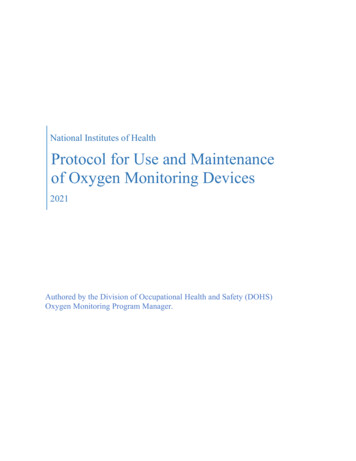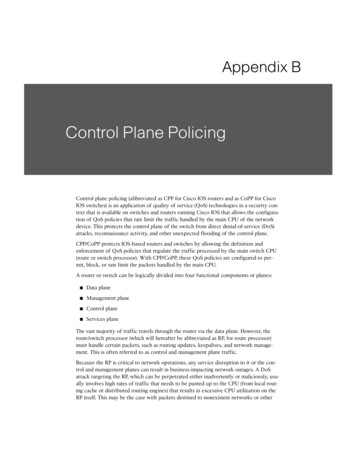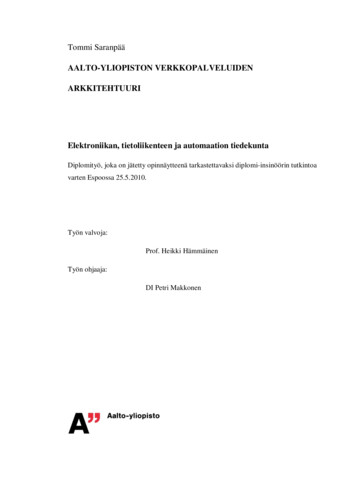
Transcription
National Institutes of HealthProtocol for Use and Maintenanceof Oxygen Monitoring Devices2021Authored by the Division of Occupational Health and Safety (DOHS)Oxygen Monitoring Program Manager.
CONTENTSINTRODUCTION . 2I.PURPOSE 2II.SCOPE . 2III.APPLICABLE REGULATORY, POLICY,AND INDUSTRY STANDARDS . 3IV.RESPONSIBILITIES . . 4V.TECHNICAL INFORMATION . 6VI.REFERENCES . 9APPENDIX A – MANDATORY SIGNAGE . 11APPENDIX B – RECOMMENDED SIGNAGE 13ACRONYMSBASDOHSDRMICMRINMROSHAPITEMTABBuilding Automation SystemDivision of Occupational Health and SafetyDesign Requirements ManualInstitute/CenterMagnetic Resonance ImagingNuclear Magnetic ResonanceOccupational Safety and Health AdministrationPrincipal InvestigatorTransmission Electron MicroscopeTechnical Assistance BranchDisclaimer of Endorsement:Reference herein to any specific commercial products, process, or service by trade name, trademark, manufacturer,or otherwise, does not necessarily constitute or imply its endorsement, recommendation, or favoring by the UnitedStates Government. The views and opinions of authors expressed herein do not necessarily state or reflect those ofthe United States Government, and shall not be used for advertising or product endorsement purposes.1
INTRODUCTIONCompressed gases and cryogenic liquids (e.g. nitrogen, helium, carbon dioxide, oxygen andargon) may be used in laboratories and other locations for various applications and workprocedures. Cryogenic liquids are gases that are kept in their liquid state through application oftemperature and pressure. Their freezing properties are advantageous when storing laboratorysamples and/or components, or to maintain extremely low temperatures and preservesuperconductivity in magnetic resonance imaging (MRI) and nuclear magnetic resonance (NMR)machines.When cryogenic liquids are dispensed, they release vapors and gases with various properties.Nitrogen and helium gases, for example, are inert, colorless, odorless, noncorrosive andnontoxic. They are also simple asphyxiants, meaning they displace oxygen from air when presentin high concentrations. Displacing oxygen creates the potential for an oxygen deficient orhazardous atmosphere, which is an occupational hazard. The Occupational Safety and HealthAdministration (OSHA) specifies that a hazardous atmosphere may include one where theoxygen concentration is below 19.5% or above 23.5%.In situations where oxygen levels exceed 23.5%, oxygen enrichment and other flammabilityhazards may be present. Per the Lawrence Berkeley National Laboratory, cryogenic liquids maycondense the surrounding air into a liquid form, which increase the oxygen concentration. This“liquid air” can be composed of up to 50% oxygen and will amplify any combustion/flammablehazards in the surrounding areas. Loose-fitting covers on storage dewars that allow for thegradual boil-off of gas and vacuum-jacketed/insulated transport lines will reduce this hazard.Compressed oxygen gas, liquid oxygen and liquid hydrogen also present additional combustionand flammability hazards.Contact the Division of Occupational Health and Safety (DOHS) Oxygen Monitoring ProgramManager for any concerns relating to hazardous atmosphere.I.PURPOSEThis protocol has been established at the National Institutes of Health (NIH) to:1)2)II.Provide guidance on the installation, maintenance, and calibration of oxygenmonitoring devices in animal and laboratory areas in all NIH owned and leasedbuildings; andIdentify and list all device locations.SCOPEThis policy applies to all NIH intramural research program personnel and contract staffsupporting intramural research at NIH campuses in Maryland, Montana, and Arizona.2
Personnel at the NIEHS Research Triangle Park campus should refer to the policies establishedfor their location. The following are common locations where compressed gases and/orcryogenic liquids are found, potentially creating a hazardous atmosphere: Magnetic resonance imaging (MRI) and nuclear magnetic resonance (NMR)rooms;Cryogenic/Transmission Electron Microscope (TEM) rooms;Freezer and tank farms;Bulk storage tanks, particularly if kept indoors or outdoors below groundlevel; andCompressed gas manifold rooms or other compressed gas bulk storage.Oxygen monitoring devices are recommended to be installed in these common locations, whichcould reside in animal, laboratory, and/or clinical areas. This recommendation is to meet generalsafety and health considerations and requirements in the NIH Design Requirements Manual(DRM) for Biomedical Laboratories and Animal Research Facilities as well as laboratoriessubject to College of American Pathologists requirements. Oxygen monitoring is often necessaryfor safe work within permit-required confined spaces. The permit-required confined spacesregulation may have some applicability and should be reviewed in conjunction with this protocoland the NIH Permit-Required Confined Spaces program.III.APPLICABLE REGULATORY, POLICY, AND INDUSTRY STANDARDS Occupational Safety and Health Administration (OSHA) Confined Space Standard29 CFR 1920.146:o “Hazardous atmosphere” means an atmosphere that may expose employees to therisk of death, incapacitation, impairment of ability to self-rescue (that is, escapeunaided from a permit space), injury, or acute illness from one or more of thefollowing causes: (1) Flammable gas, vapor, or mist in excess of 10 percent of its lowerflammable limit (LFL) (3) Atmospheric oxygen concentration below 19.5 percent or above 23.5percent;o Before an employee enters the space, the internal atmosphere shall be tested, witha calibrated direct-reading instrument, for oxygen content, for flammable gasesand vapors, and for potential toxic air contaminants, in that order.Occupational Safety and Health Administration (OSHA) Respiratory ProtectionStandard 29 CFR 1920.134:o “Oxygen deficient atmosphere” means an atmosphere with an oxygen contentbelow 19.5% by volume.o All oxygen-deficient atmospheres shall be considered immediately dangerous tolife and health (IDLH).**College of American Pathologists (CAP) Accreditation Program Requirements:3
GEN.77550Liquid Nitrogen and Dry IceAdequate policies, procedures, and practices are in place for the use ofliquid nitrogen and dry ice.GEN.84800Environment MaintenanceThere are oxygen sensors or sufficient airflow to preventasphyxiation in areas where liquid nitrogen is used.**CAP Program Requirements apply to CAP-accredited programs only. Please contact theDOHS Oxygen Monitoring Program Manager at 301-496-3353 or OxygenMonitoring@nih.govfor more information. National Institutes of Health Design Requirements Manual 13.10.7: Liquid Nitrogen(LN2):o “Oxygen monitoring shall be provided in freezer rooms and other rooms wherecryogenic fluids are supplied to warn of oxygen depletion ”IV.RESPONSIBILITIESInstitute/Center (IC): Contact the Division of Occupational Health and Safety (DOHS) to request a riskassessment for locations that use compressed gases and/or cryogenic liquids.o Notify the DOHS if significant changes in the volume of gas, work practices,and/or ventilation conditions occur in areas that have previously been surveyed.As applicable, ensure proper oversight and maintenance of bulk storage tanks anddelivery systems for compressed gases and/or cryogenic liquids.Ensure oxygen monitoring devices are installed, maintained, and calibrated as perguidance in this protocol.o A service contract may be established with the manufacturer to meet theseobligations.o The IC shall keep written and/or electronic records for all actions related to:installation, calibration, maintenance, etc.Display mandatory (see Appendix A) and recommended (see Appendix B) signage asapplicable. Signage shall be displayed in easily viewable locations.Conduct bulk tank inspections as detailed in the Section V “Bulk Tank InspectionSchedule” below.o A service contract may be established with the manufacturer to meet theseobligations.o The IC shall keep written and/or electronic records for all actions related to:inspections, defects, maintenance, etc.4
Division of Occupational Health and Safety (DOHS) Safety Operations and Support Branch(SOSB) Safety Personnel: Assist in hazard recognition to determine the potential need for oxygen monitoringdevice(s).Refer oxygen monitoring issues and inquires to the DOHS Oxygen Monitoring ProgramManager.NOTE: The SOSB Safety Specialist and the IC should review related health and safetyconsiderations not specific to this protocol, such as the safe handling and storage ofcompressed gases and/or cryogenic liquids. For example, compressed gases should bestored upright and secured. As a result of the significant freezing hazards related to thehandling of liquid nitrogen and helium, proper personal protection equipment (PPE)—such as, loose-fitting insulated gloves and goggles/face shields—must be worn whenhandling and dispensing these cryogenic liquids. Also, containers used to transportliquid nitrogen, such as dewars, should be used in a safe and appropriate manner.DOHS Technical Assistance Branch (TAB) Oxygen Monitoring Program Manager: Conduct building surveys on a 3-year cycle to validate inventory of oxygen monitoringdevices and identify new locations where compressed gases and/or cryogenic liquids arein use.o Provide guidance and oversight for DOHS technicians who provide programsupport in oxygen monitoring surveys.Perform risk assessments for locations where installation of a fixed oxygen monitoringdevice may be recommended.Assist locations in preparation for accreditation inspections where compressed gas and/orcryogenic liquids storage and handling are a component of inspection (i.e. College ofAmerican Pathologist accreditation).Provide support to NIH Office of Research Facilities (ORF) locations where oxygendeficient and/or enriched areas may be present.Coordinate with NIH campus vendors to maintain awareness of potential safety issuesrelating to storage and handling of compressed gases and/or cryogenic liquids.Provide support regarding the technical aspects of installation, maintenance, andcalibration.o If the manufacturer is not retained to calibrate the units, the Oxygen MonitoringProgram Manager will review accepted vendors to calibrate the units.Annually review and update this protocol.5
V.TECHNICAL INFORMATIONInstallation:An oxygen monitoring device shall be installed in any indoor location where compressed gasesand/or cryogenic liquids are stored and/or dispensed in manner that could create the potential forthe displacement of oxygen. The NIH DRM notes that both “carbon dioxide manifold rooms [and] nitrogen holding rooms shall include oxygen level monitoring alarms”. At a minimum, thefollowing factors should be used in determining if a device should be installed: manufacturer(e.g., magnet) guidance, volume of gas used, work practices, location of gas, and ventilationestimates in the room/area. Additionally, compressed gases or cryogenic liquids shall not belocated or dispensed in any indoor location that does not have adequate ventilation.The IC should contact their DOHS Safety Specialist and perform an assessment of the activitiesand area with respect for the need of an oxygen monitoring device. Compressed gases used forinstrument calibration, for example, may not require the installation of an oxygen monitoringdevice.The installation of the oxygen monitoring device will rely on the manufacturer’s specificrequirements and recommendations. Some of these requirements may include, but not be limitedto:1) Installing the device sensor(s) close to an area where a gas release would mostlikely occur;2) Placing the device sensor(s) at the proper height depending on the density of thegas and the simulation of an individual’s breathing zone;3) Ensuring the device’s display is accessible; and4) Performing a leak test of the oxygen monitoring device’s sample lines, systemcomponents and fittings.Alarm Notification:As per the manufacture’s recommendation, a low oxygen alarm shall be installed along with themonitoring device to alert persons in the surrounding area of a hazardous condition. If possible,the monitoring device should also be interlocked with the building automation system (BAS).Where applicable, the device shall also be interlocked with an emergency exhaust fan orventilation system that is located at the monitored location. An alarm will trigger emergencyventilation of the space. Alarms installed during new construction, or building alteration, shouldinclude both visual and audible warnings to notify occupants. If BAS interlocking is not possible,the alarm will alert local occupants but will not notify any emergency response systems.Alarm SetpointsOSHA specifies that a hazardous atmosphere may include one where the oxygen concentration isbelow 19.5% or above 23.5%. The device alarm and warning levels should be set according tothese oxygen concentration levels.6
If both oxygen enrichment and oxygen deficiency are a concern, the alarm setpoints should beset to reflect these levels. For oxygen monitors where multiple setpoints are possible, such as“Caution,” “Warning,” and “Alarm,” setpoints can be programmed according to the hazardspresent in the environment. If oxygen levels reach the “Alarm” setpoint, the alarm in someoxygen monitors may “latch,” and will not stop alarming unless physically reset. The “latch”setting is a safety feature that requires a physical check of the space to determine that it has beencleared of occupants in an emergency and that no one has been overcome by a hazardousatmosphere.Maintenance and Use:General maintenance/troubleshooting:Any maintenance or repair on the monitoring device should only be performed by themanufacturer or manufacturer’s representative using manufacturer specific replacement parts.Most oxygen monitoring devices require minimal periodic maintenance. The device itself can beperiodically cleaned with a clean, dry cloth.Sensor replacement:Oxygen sensors are the main monitoring components of these devices. Sensor replacement isdictated by the manufacturer of the oxygen monitoring device. The scheduled replacementrequirements should be noted by the IC during installation. For example, oxygen sensors on theMSA Toxgard II Monitor typically last a maximum of two years. Some devices may also give adisplay reading when the sensor needs to be replaced. The IC shall have a program in place totrack and ensure the proper maintenance of each monitor.Calibration:Calibrations are performed to verify the accuracy of the oxygen sensor, which is the maincomponent of an oxygen monitoring device. There are generally two different types ofcalibrations: initial and 12-month interval. Initial and 12-month interval calibrations should beperformed by the manufacturer or manufacturer’s representative. Records shall be kept of allcalibrations, preferably in a designated notebook located near the alarm (readily available to aspot check inspection).Initial Calibration:An initial calibration must be performed by the manufacturer or manufacturer’s representativewhen an oxygen monitoring device and/or new oxygen sensor is installed.7
12-Month Interval Calibrations:These calibrations should be performed by the manufacturer or manufacturer’s representativeeither every 12 months or per the recommendation of the manufacturer, whichever is morefrequent. A more frequent calibration schedule may be necessary if readings are out of range.The building automation system connection (BAS) and emergency exhaust fan, whereapplicable, should also be verified as operational during the 12-month interval calibration.Additionally, a leak check of the sample lines, system components and fittings should also beperformed at the interval calibration.If the manufacturer is not retained to calibrate the units, a third-party vendor must be retained tocalibrate the units.The IC shall keep written and/or electronic records for all actions related to: installation,calibration, maintenance, etc. Additional calibration stickers placed on/near the oxygen monitorare encouraged as a clear visual indicator of when the unit is due for calibration.Daily Observation Checks:The display/readout on the device should be visually checked daily to ensure that the device isfunctioning, and oxygen levels are within normal parameters.Bulk Tank Inspection Schedule:ItemValves and fittings for leaks and othermalfunctionsIndicating gauges for malfunctionRelief valves and rupture discs to verify propersettingsFoundation anchorsInspection IntervalAnnuallyAnnually2 years5 yearsReference: Safety Checks for Vacuum Insulated Cryogenic Tanks, British Compressed Gas Association (2014).Space intentionally left blank8
VI.REFERENCESCollege of American Pathologists (CAP). GEN.77550: Liquid Nitrogen and Dry reditation/accreditation-checklists.September 2020)(29College of American Pathologists (CAP). GEN.84800: Environment er 2020)(29Compressed Gas Association (CGA) P-12-2017 Safe Handling of Cryogenic ils.aspx?id P-12 (29 September 2020)British Compressed Gas Association (BCGA). The Safe Use of Liquid Nitrogen Dewars – Codeof Practice 30. www.bcga.co.uk (29 September 2020)Lawrence Berkeley National Lab Safety Manual. Chapter 29 Safe Handling of CryogenicLiquids – Safety nic Liquid Hazards and Controls (29 September2020)Mine Safety Appliance Company (MSA). Monitoring for Oxygen Deficiency: MRI Units – DataSheet. (March ppliances/Toxgard%20II%20MRI%20bulletin%20-%20EN (29 September 2020)Mine Safety Appliance Company (MSA). Toxgard II Monitor – Instruction Manual, Rev. N (29 September 2020)National Fire Protection Association (NFPA). Standard 45-2019. Standard on Fire Protection forLaboratories Using s/detail?code 45 (29 September 2020)National Fire Protection Association (NFPA). Standard 55-2020. Compressed Gases andCryogenic Fluids Code. ode 55 (29 September 2020)NIH Design Requirements Manual (DRM). Section 13.10.7 Liquid Nitrogen s/Pages/DesignRequirementsManual2016.aspx (29 September 2020)9
NIH ORF Occupational Health & Safety Manual, Section 3-3 – Confined s/Pages/DesignRequirementsManual2016.aspx (29 September 2020)Occupational Safety & Health Administration (OSHA). Permit Required Confined-Spaces –1910.146. dnumber/1910/1910.146 (29September 2020)Occupational Safety & Health Administration (OSHA). Respiratory Protection Standard –1910.134. dnumber/1910/1910.134 (29September 2020)Space intentionally left blank10
APPENDIX A – MANDATORY SIGNAGEInstruction:A minimum of two signs is required with every oxygen monitoring device installation: Sign A instructs room occupants to evacuate immediately if the alarm sounds.o Sign A shall be posted as close as possible to each oxygen monitoring device in aposition that allows for clear visibility to the room occupants.Sign B prevents additional personnel from entering a room with an alarm sounding andshall be posted on or adjacent to the outside of each entry door to a room with an oxygenmonitoring device at approximately eye level.o Sign B has a fillable component to insert at least two local emergency contacts(e.g. lab manager and PI).Space intentionally left blank11
Sign A:Sign B:12
APPENDIX B – RECOMMENDED SIGNAGEInstruction:Additional signage is recommended in areas where compressed gases and/or cryogenic liquidsare stored in publicly accessible locations, where cryogenic liquids are dispensed, and/or toincrease general awareness of safe handling and storage practices.Sign A issues a caution about potential cold hazards in areas where cryogenic liquids are storedin public areas (e.g. hallways, freight elevator lobbies). Sign A should be posted near cryogenicliquid vessels in a position that allows for clear visibility to passersby. Sign A has a fillablecomponent to insert at least two local emergency contacts (e.g. lab manager and PI).Sign B provides instruction on safe handling and storage of compressed gases. Sign B should beposted near compressed gas storage areas in a position that allows for clear visibility tooccupants.Sign C provides information on appropriate Personal Protective Equipment (PPE) when handlingcryogenic liquids (e.g. dispensing cryogenic liquids, storing or removing samples fromcryostorage tanks). Sign C should be posted near cryogenic liquid vessels in a position thatallows for clear visibility to users.Sign D provides information on safe dispensing of cryogenic liquids (e.g. filling liquid nitrogendwars). Sign D should be posted at cryogenic liquid dispensing sites in a position that allows forclear visibility to users.Space intentionally left blank13
Sign A:Sign B:14
Sign C:Sign D:15
GEN.77550 Liquid Nitrogen and Dry Ice Adequate policies, procedures, and practices are in place for the use of liquid nitrogen and dry ice. GEN.84800 Environment Maintenance There are oxygen sensors or sufficient airflow to prevent asphyxiation in areas where liquid nitrogen is used. **CAP Program Requirements apply to CAP-accredited programs only.










